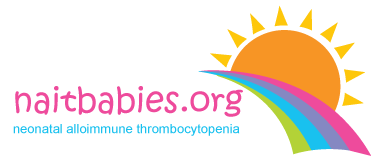A–B–C-D-E-F–G–H–I-J-K-L-M-N-O-P-Q-R-S–T-U-V-W-X-Y-Z
(Note: spellings are in English. American English spellings may differ slightly)
A
Allele
One of two or more alternative forms of a gene that occupy corresponding loci on homologous chromosomes. Each allele encodes a phenotypic feature or a certain inherited characteristic. An individual normally has two alleles for each gene, one contributed by the mother and one by the father. If both alleles are the same, the individual is homozygous; if the alleles are different, the individual is heterozygous.
Alloimmune
Immunity to an alloantigen. (Alloimmunity should not be confused with autoimmunity in which the body’s immune system attacks its own cells without being provoked or influenced by substances or cells from another member of the same species).
Alloantigen
An antigen existing in alternative (allelic) forms in a species, thus inducing an immune response when one form is transferred to members of the species who lack it; typical alloantigen are the blood group antigens.
Angiogenesis
1. Development of blood vessels in the embryo. 2. Any formation of new blood vessels.
Antigen
Every living cell has different protein markers on its surface called antigens, and the body’s immune system identifies those cells that are not part of its structure by those surface proteins.
Antibody
The body uses anyibodies to attack and remove foreign substances. Antibody level in the blood is a reflection of past exposure to an antigen or to something that the body does not recognize as belonging to itself.
Antibody titer
Laboratory test that measures the presence and amount of antibodies in blood.
Autoimmune
Of or relating to an immune response by the body against one of its own cells or tissues.
B
Blood
Fluid consisting of plasma, red blood cells, white blood cells, and platelets that is circulated by the heart through the arteries and veins, carrying oxygen and nutrients to and waste materials away from all body tissues.
C
Chromosome
An organized structure of DNA and protein that is found in cells. It is a single piece of coiled DNA containing many genes, regulatory elements and other nucleotide sequences. Chromosomes also contain DNA-bound proteins, which serve to package the DNA and control its functions.
Cordocentesis
Cordocentesis is also known as Fetal Blood Sampling, Percutaneous Umbilical Blood Sampling (PUBS), and Umbilical Vein Sampling.
Corticosteroids
Any of several steroid hormones secreted by the cortex of the adrenal glands. Also synthetic forms with similar properties. Corticosteroids have anti-inflammatory and immunosuppressive effects and may be used to treat a number of conditions. Side effects can be serious, and therapy must be withdrawn very gradually.
F
FBS
Fetal blood sampling.
Fetal
Relating to a fetus.
Fetus
In humans, the unborn young from the end of the eighth week after conception to the moment of birth.
FMAIT
Feto-maternal alloimmune thrombocytopenia.
FNAIT
Fetal and neonatal alloimmune thrombocytopenia.
G
Genotype
The complete genetic constitution of an individual at a particular location (locus) in the genome. At many locations (loci) throughout the genome, the chromosomal DNA sequence differs subtly between individuals. Each of the various DNA sequences at one locus is called an allele: for instance, if there are three sequence variants present, then there are three alleles. Offspring inherit one homologous chromosome from each parent. Thus, a genotype comprises two alleles: the allele inherited from the father (carried on the paternal chromosome) and the allele inherited from the mother (carried on the maternal chromosome)
H
Haemorrhage
Bleeding – the flow of blood from a ruptured blood vessel.
Heterozygous
Refers to having inherited different forms of a particular gene from each parent.
Homozygous
Refers to having inherited the same forms of a particular gene from both parents.
HLA
Human leukocyte antigen system (HLA) is the name of the major histocompatibility complex (MHC) in humans. The super locus contains a large number of genes related to immune system function in humans
HPA
Human platelet alloantigen.
I
ICH
Intracranial haemorrhage. Bleeding within the skull.
Intravenous
Administering fluids or medicines into the veins.
Immunisation
To make somebody resistant to a disease, especially by inoculation.
IVIG
Intravenous immunoglobulin is a blood product administered intravenously. It contains the pooled IgG (immunoglobulin (antibody) G) extracted from the plasma of over a thousand blood donors.
IVH
Intraventricular haemorrhage. Bleeding into the brain.
N
NAIT
Neonatal alloimmune thrombocytopenia.
Neonate
Newborn.
Neonatal
Relating to or affecting newborn children, and up to four weeks old.
NICU
Neonatal Intensive Care Unit.
P
Percutaneous
In surgery, percutaneous pertains to any medical procedure where access to inner organs or other tissue is done via needle-puncture of the skin.
Petechiae
Pinpoint hemorrhage in the skin (<2mm).
Platelet
Minute, irregularly shaped, disk like cytoplasmic body found in blood plasma that promotes blood clotting. Also called blood platelet, thrombocyte.
Prednisone
Synthetic corticosteroid drug that is particularly effective as an immunosuppressant drug.
PUBS
Percutaneous Umbilical Blood Sampling.
S
Steroid
Type of hormone.
T
Thrombocytopenia
Abnormal drop in the number of blood cells involved in forming blood clots. These cells are called platelets. The normal amount of platelets is usually between 150,000 and 450,000 cells per microlitre of blood.
V
VBAC
Vaginal delivery after caesarean.
Ventouse
Vacuum device used to assist the delivery of a baby when labour has not progressed adequately. It is an alternative to a forceps delivery and caesarean section.
